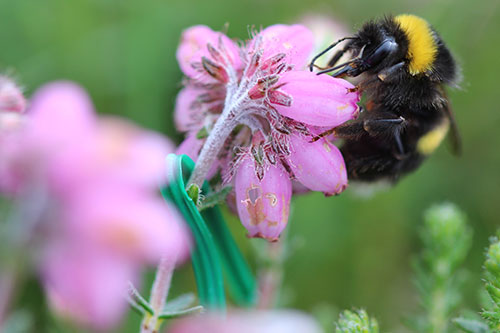Flowers receive a wide range of visitors, but not all of them are equally effective at depositing pollen. By measuring visits and pollen deposition to all flower species on a heathland in Dorset the team have captured new data which will allow conservationists to identify the most important plant visitors and plants that are at risk, as well as helping to plan for food security.
Previous studies have often focused on the number of visits plant pollinators make to flowers, rather than how effective they are at pollination. However, this approach may not always recognise variance in pollination abilities due to pollen thieves or other visitors that are inefficient at moving pollen and may not benefit the flowers.
However the research, published today in Proceedings of the Royal Society B, investigated pollen deposition onto stigmas of flowers of the five most common plant species found in the Dorset heathland.
This approach has enabled researchers to develop pollinator importance networks, which not only reveal that bumblebees are the main flower visitors at the Dorset heathland site, but that they are also the most successful potential pollinators. Among the other top-performers in this insect super-league were honeybees and solitary bees.
Lead author Dr Gavin Ballantyne of the University of St Andrews’ School of Biology said: “Vital crops such as oilseed rape, apples and strawberries, as well as thousands of wild plants, all require pollination by a wide range of animal pollinators which can be visualised as a network of interacting species. However, the structure and stability of these wider networks are not fully understood and the plant and insect species involved may often be under threat.
“Understanding how pollinator importance networks, like those we studied on Dorset heathland, are structured is crucial to understanding community interactions and thus how to restore and conserve pollination services in the face of pollinator decline.”
Co-author Dr Katherine Baldock of Bristol's School of Biological Sciences said: “This study represents an important step forward in how we understand the relationships among plants and their pollinators. Including information on the pollinating efficiency of animals that visit flowers in network studies will lead to a greater understanding of how these complex communities are structured and which species are important pollinators of crops and wild flowers.”
However the research also warns against focusing on chart-topping bees as the solution to conservation and biodiversity concerns. Although bees deposited the greatest mean quantities of pollen grains on stigmas, deposition rates were highly variable and many visitor groups had an important role to play. This means that more attention must be paid to a wider network of insects if food production and biodiversity are to remain stable.
Paper
‘Constructing more informative plant–pollinator networks: visitation and pollen deposition networks in a heathland plant community’ by G. Ballantyne, Katherine C. R. Baldock, P. G. Willmer in Proceedings of the Royal Society B [Open Access]
